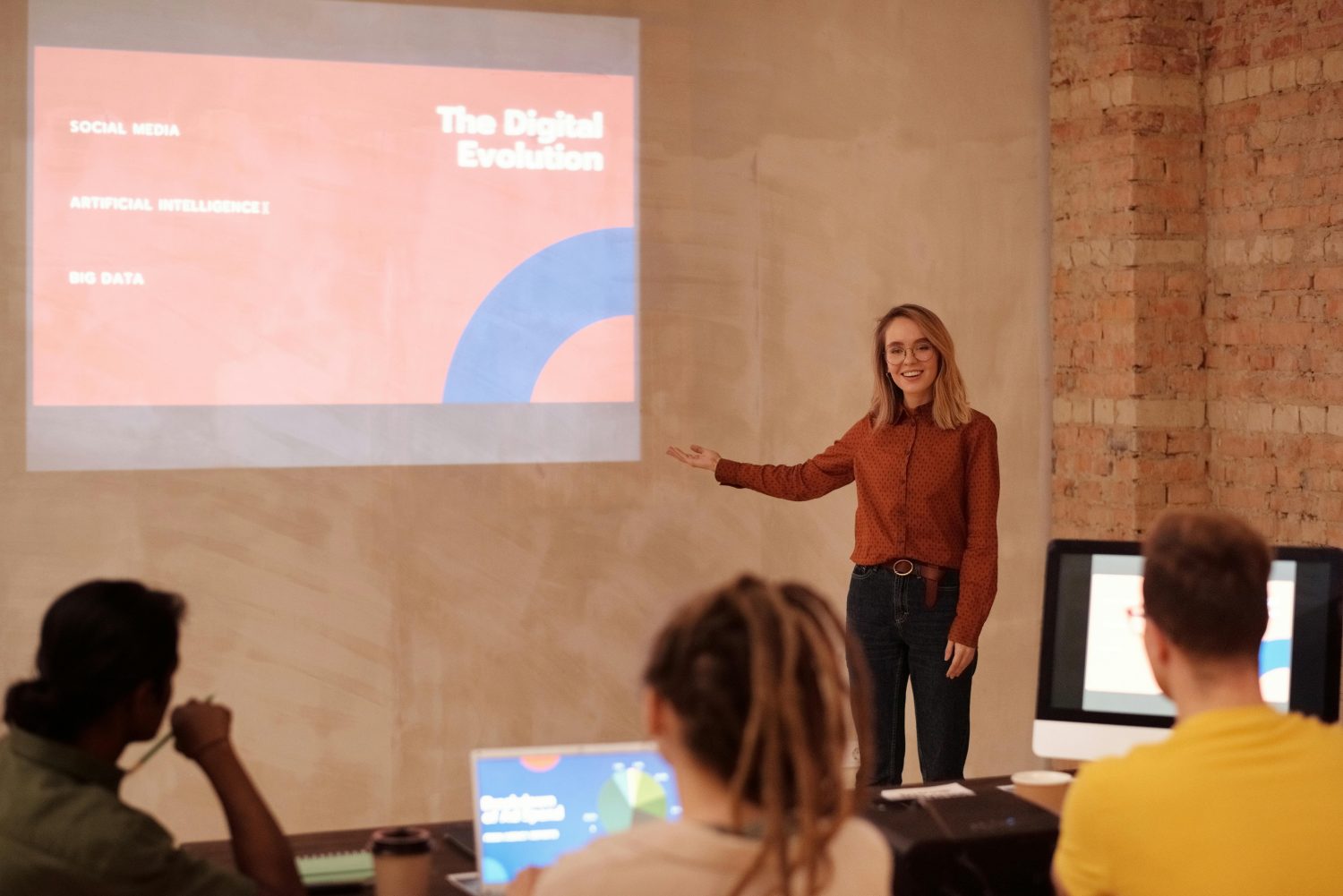Don’t let your brand stay confined by the limitations of your local market. Discover the untapped potential of global markets with the power of Artificial Intelligence in video conversion! This article will guide you on how to dominate new markets, increase sales, and reach a wider audience, all by changing your approach to video content. Let’s look into the amazing ability of AI and its impact on market reach. Leveraging AI for video conversion can help businesses tap into new, previously inaccessible markets by creating content that can be easily consumed across different devices and regions, potentially enhancing revenue streams.
Implementing AI into Your Video Conversion Strategy
1. First we will discuss the power of artificial intelligence to enhance your video conversion strategy. This section will break down the complex world of AI, providing clear insights into how it operates in the context of video conversion.
2. Secondly, we will explain how the right AI tools can turbocharge your video conversion process, but finding the perfect fit is often challenging. This section will guide you in curating an AI suite that seamlessly aligns with your video conversion goals.
3. Lastly Engaging AI in your existing video conversion process requires a marriage between old and new. In this discussion, you’ll learn practical strategies for integrating AI tools into your current workflow, fostering innovation without disrupting productivity.
Understanding the Basics of AI for Video Conversion
Understanding the Basics of AI for Video Conversion involves grasping how artificial intelligence and machine learning algorithms can automate the time-consuming process of converting videos into different formats and resolutions. Companies like Google and IBM have developed innovative AI tools that can convert videos at an impressively high speed and with an enhanced level of quality.
For instance, Google’s Video Intelligence API provides features such as object detection, shot change detection, and video transcription, just to mention a few. Besides, AI algorithms can analyze a vast amount of data related to file size, codec, frame rate, and bandwidth to optimize video for various platforms, thus ensuring a smooth viewer experience.
To further illustrate, Netflix uses similar technology to deliver video content to millions of subscribers worldwide, adapting video quality according to users’ Internet connection speed. Familiarizing with these basics can help to build a robust and efficient video conversion strategy that incorporates AI to serve your specific needs.
- Grasp how AI and machine learning can automate video conversion into different formats and resolutions, enhancing speed and quality.
- Understand the features of AI tools like Google’s Video Intelligence API (object detection, shot change detection, video transcription) and how AI optimizes video for various platforms analyzing data related to file size, codec, frame rate, and bandwidth.
- Learn from companies like Netflix, which adapt video quality according to users’ internet speed, to build a robust and efficient video conversion strategy using AI.
Selecting Suitable AI Tools for Your Video Conversion Strategy
Choosing the right AI tools is a critical step in developing a successful video conversion strategy. Depending on your technical expertise, budget, and specific needs, there are several AI tools available in the market that can enhance the speed and quality of video conversions.
For example, tools like FFmpeg, HandBrake, and Adobe Media Encoder leverage AI to provide exceptional video conversion capabilities. These tools incorporate advanced algorithms to improve the video resolution, sharpen images, reduce noise, and adaptively adjust the video bit rate based on the complexity of the video.
Smooth transitions between videos, synchronization of audio and video streams, and additional video effects are some additional features provided by these tools. Thus, by carefully selecting and integrating such suitable AI tools into your strategy, it’s possible to achieve high-quality video content conversion with increased efficiency.
- Identify your technical expertise, budget, and specific needs to choose the right AI tools for video conversion.
- Consider AI tools like FFmpeg, HandBrake, and Adobe Media Encoder that provide exceptional video conversion capabilities such as improving video resolution, sharpening images, reducing noise, and adaptively adjusting the video bit rate.
- Incorporate suitable AI tools into your strategy for achieving a smooth transition between videos, synchronization of audio and video streams, adding video effects, and overall high-quality video content conversion with increased efficiency.
Integrating AI Tools into Your Existing Video Conversion Process
Incorporating AI tools into your current video conversion process can optimize the speed and accuracy of tasks, enhancing both productivity and outcomes.
These AI-powered software applications employ algorithms and deep learning to conduct advanced and meticulous video editing tasks such as quality enhancement, format conversion, and scene detection at a rapid rate.
For instance, tools like IBM’s Watson Media can analyze and interpret unstructured data in videos more effectively, translating into faster and more sophisticated video conversions.
Moreover, Adobe’s Sensei integrates AI and machine learning to streamline the video conversion process by automating mundane tasks and making intelligent suggestions.
By seamlessly merging these AI tools into your video conversion process, you can not only improve accuracy and efficiency but also preserve resources and foster innovation within your operations.
Enhancing Conversion Using Artificial Intelligence
Artificial Intelligence holds the potential to improve the concept and effectiveness of conversions in marketing. This section unveils the magic that lies in understanding conversions through AI lenses, optimizing them with AI tools, and tracking conversion data to yield game-changing results.
Understanding the Concept of Conversion in AI
In artificial intelligence (AI), conversion is a term that pertains to the rate at which AI technologies influence or facilitate consumer behaviors, leading toward desired actions or results, such as making a purchase or filling out a form on a website.
For instance, an AI-powered chatbot can draw on data-driven insights to provide personalized recommendations, driving up the conversion rate by creating an environment more conducive to making a purchase.
The more sophisticated the AI, the more precisely and effectively it can influence consumer behaviors.
To further this concept, companies are combining AI with machine learning algorithms, enabling these bots to self-learn from each interaction and adapt their strategies, eventually leading to improved conversion rates.
Hence, understanding the concept of conversion in AI isn’t just about recognizing a term, but about grasping its potential in enhancing customer experience and boosting business outcomes.
Deploying AI Tools to Improve Conversion Rates
Deploying AI tools can significantly improve e-commerce conversion rates. AI-driven software like chatbots or personalized recommendation engines has proven advantageous.
For instance, a study by Accenture revealed that 91% of consumers are more likely to purchase from brands that provide personally relevant offers and recommendations. In addition, e-commerce giant, Amazon, attributes up to 35% of its sales to its cross-selling via AI-driven “Customers who bought this also bought…” recommendations.
This highlights how AI tools can be leveraged to enhance engagement, offering personalized suggestions and increasing the likelihood of customer conversions. Therefore, businesses aiming to boost their conversion rates should consider integrating AI tools into their marketing strategies.
- Deploy AI tools such as chatbots or personalized recommendation engines to enhance e-commerce conversion rates.
- Provide personally relevant offers and recommendations to consumers, boosting their purchase likelihood.
- Integrate AI tools into marketing strategies to enhance customer engagement and increase sales.
Tracking and Analyzing Conversion Data with AI
Implementing artificial intelligence (AI) can significantly augment the tracking and analysis of conversion data, thereby expediting the decision-making process and enhancing business performance.
In essence, AI can sift through an enormous amount of conversion data, identify patterns often overlooked by humans, and predict customer behavior with impressive accuracy.
For instance, machine learning, a subset of AI, can forecast conversion rates by training on substantial datasets of past customer interactions.
A study revealed that businesses employing AI for conversion tracking and analysis reported a 15% improvement in their conversion rates.
Therefore, such applications of AI not only provide comprehensive insights into consumer behavior but also equip businesses with a strategic advantage in the highly competitive digital marketplace.
Tracking Market Reactions to Your AI Video Conversion
Beneath the allure of AI Video Conversion lies an intricate web of data that monitors its influence on market reactions. Grasping the Key Performance Indicators (KPIs), probing into audience engagement, and harnessing the power of data analysis tools unravel this web, enabling a holistic reading of market responses.
Understanding the Key Performance Indicators (KPIs) for Your AI Video Conversion
Understanding the key performance indicators (KPIs) for your AI video conversion is a significant part of gauging the market’s reaction to your technological efforts. KPIs such as conversion rates, viewing time, viewer engagement, and bounce rates can offer valuable feedback on the effectiveness of your AI video conversion in attracting and retaining customers’ attention.
For instance, a high conversion rate could indicate that viewers find the AI-enhanced videos appealing and easy to understand. Meanwhile, extended viewing times reveal a high level of customer satisfaction and interaction.
On the other hand, increased bounce rates may indicate a need for adjustment in AI application or content presentation to better suit your audience’s preferences. Thus, these quantifiable values serve as crucial tools in monitoring the performance of your AI video conversion and act as a compass guiding your strategies toward market preferences.
- Understand the Key Performance Indicators (KPIs) for your AI video conversion to measure market reaction to technological efforts. KPIs such as conversion rates, viewing time, viewer engagement, and bounce rates should all be monitored.
- Analyze these KPIs for valuable feedback, such as high conversion rates indicating viewer appeal and extended viewing times indicating high satisfaction levels.
- Use increased bounce rates as an indication of a need for adjustments in AI application or content presentation to better suit your audience’s preferences. Leverage these quantifiable values to guide your strategies toward market preferences.
Analyzing Audience Engagement and Behavior
Understanding and analyzing audience engagement and behavior is critical in evaluating the market reactions to AI video conversion. Multiple tools exist that provide comprehensive, data-driven insights into how consumers interact with video content.
For instance, heat maps display the points of interest in a video that attracts the most attention, showing how long viewers watch and when they lose interest. Audience retention graphics can further illustrate when viewership drops off, highlighting whether key messages hold attention or result in user disengagement.
This detail-rich data aids companies in making apt decisions, immediate adjustments, and long-term strategies for their video content. Consequently, these metrics of audience engagement and behavior serve as indicators of the market’s response to your AI video conversion and can help in shaping your strategy for future video content creation.
- Understand and analyze audience engagement and behavior to evaluate market reactions to AI video conversion.
- Utilize tools such as heat maps and audience retention graphics to understand viewer interest and pinpoint potential areas of user disengagement.
- Use this valuable data to make informed decisions, adjustments, and strategic plans for future video content, optimizing audience engagement.
Utilizing Data Analysis Tools for Market Reaction Tracking
Utilizing data analysis tools for market reaction tracking is a critical aspect of the effectiveness of your AI video conversion strategies.
These tools, such as Google Analytics or Tableau, allow businesses to meticulously analyze the organic interaction data resulting from the release of AI-converted videos, thereby providing a quantitative measure of market response.
For instance, the data can reveal details regarding viewer engagement such as the average watch time, the percentage of viewers watching the video until the end, and the click-through rate.
This valuable information can be used to identify patterns and trends, providing the foundation for further strategy adjustments and improvements.
Indeed, a smooth, seamless understanding of the data through these analysis tools can pave the way to creating more impactful and targeted AI video content, maximizing your reach and efficacy in the market.
- Utilize data analysis tools like Google Analytics or Tableau for market reaction tracking to evaluate the effectiveness of AI video conversion strategies.
- Analyze the organic interaction data such as average watch time, percentage of viewers watching the video until the end, and the click-through rate to gauge market response.
- Use the obtained data to identify trends, make strategy adjustments and improvements, and create more impactful and targeted AI video content.
Adjusting AI Video Conversion Strategy Based on Feedback
Utilizing insightful feedback and analytics can drastically transform your AI video conversion strategy to produce more compelling results. This section embarks on a journey exploring the interpretation of feedback, improving AI algorithms based on this feedback, and refining the video conversion strategy accordingly.
Interpreting Feedback and Analytics
Understanding and evaluating feedback and analytics is a crucial aspect when refining your AI video conversion strategy. The feedback data sourced from users can illuminate which elements of your AI strategy are resonating with people, and which might need to be adjusted or eliminated.
For instance, a high dropout rate might suggest that the video content is too long or not engaging enough. Alternatively, an unexpected uptick in engagement could indicate a successful tweak to your strategy.
Furthermore, analytics can offer valuable insights into user behavior patterns, such as the times when users are most active or the devices most commonly used for interaction. All these insights can be used to iteratively improve and tailor your strategy to the needs and preferences of your users, ultimately enhancing their experience and the effectiveness of your AI video conversion strategy.
Improving AI Algorithm Based on Feedback
Improving AI algorithms based on feedback is a crucial aspect of fine-tuning any AI video conversion strategy. As AI systems inherently learn from their environment, incorporating user feedback can lead to significant improvements in the accuracy and efficiency of video conversion algorithms.
For example, YouTube uses machine learning algorithms to improve video quality based on user feedback about buffering or resolution problems. Based on unique user preferences and recurring issues, the algorithm adapts over time, optimizing overall video quality and user experience.
Therefore, continuous feedback integration, followed by testing, is an indispensable step for the evolution of robust and efficient AI algorithms. Utilizing this practice as a transition, the AI video conversion strategy becomes a dynamic, continually evolving process, significantly enhancing its effectiveness and user satisfaction.
Updating Video Conversion Strategy
In the process of adjusting based on feedback, updating your video conversion strategy is crucial.
Continuous monitoring of audience feedback and user data can reveal valuable insights that can guide the optimization of the AI video conversion algorithm.
For instance, if analytics indicates that certain video formats are more favored by the target audience, these can be prioritized in the conversion process.
Feedback can also unveil potential issues in the current video conversion process, such as lower resolutions or slower processing speeds, leading to enhancements that significantly improve user satisfaction and engagement.
Regular updates to the video conversion strategy, driven by a deep understanding of user behavior and preferences, thus serve to enhance the overall effectiveness and reach of the AI solution.
Frequently Asked Questions
Q: What does leveraging AI for video conversion mean?
Leveraging AI for video conversion means using artificial intelligence and machine learning algorithms to automate the process of converting videos into different formats and resolutions. This allows businesses to tap into new markets by creating content that can be easily consumed across different devices and regions, potentially enhancing revenue streams. AI algorithms can analyze a vast amount of data related to file size, codec, frame rate, and bandwidth to optimize video for various platforms, ensuring a smooth viewer experience.
Q: How can AI tools be integrated into my video conversion strategy?
Integrating AI tools into your video conversion process involves identifying your technical needs and budget, choosing the right AI tools for video conversion such as FFmpeg, HandBrake, or Adobe Media Encoder, and employing these tools into your existing process. AI-enhanced software can automate editing tasks such as quality enhancements, format conversions, and scene detection, significantly improving productivity and outcomes.
Q: What role does AI play in understanding conversions in marketing?
In marketing, AI technologies can influence or facilitate consumer behaviors leading toward desired actions or results, like making a purchase or filling out a form on a website. For instance, AI-powered chatbots can use data-driven insights to provide personalized recommendations, driving up the conversion rate. Companies that understand this potential can incorporate AI to enhance their customer experience and boost business outcomes.
Q: How can AI tools improve conversion rates?
Deploying AI tools like chatbots or personalized recommendation engines can significantly improve e-commerce conversion rates. These tools enhance engagement by offering personalized suggestions to customers, increasing the likelihood of conversions. A business that wishes to improve its conversion rates should consider integrating AI tools into its marketing strategies.
Q: How can I track market reactions to my AI video conversion?
Tracking market reactions can be done by understanding the Key Performance Indicators (KPIs) for your AI video conversion such as conversion rates, viewing time, viewer engagement, and bounce rates. Monitoring these KPIs provides valuable feedback on the effectiveness of your strategy. Additionally, analyzing audience engagement and behavior as well as utilizing complex data analysis tools such as Google Analytics or Tableau can offer comprehensive insights into how your AI video content is resonating with your market.
Q: How can feedback and analytics improve my AI video conversion strategy?
User feedback and analytics data can provide critical insights into which aspects of your AI strategy are effective and which need adjustments. For instance, a high dropout rate might suggest that the video content is too long or not engaging. Feedback can also be used to improve your AI algorithm, as it can improve the accuracy and efficiency of video conversion. Feedback and analytics therefore have a significant role in refining and optimizing your AI video conversion strategy for better user satisfaction and effectiveness.
Featured Image Credit: Photo by vecstock; Freepik; Thank you!









